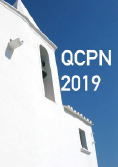Speaker
Description
A quantitative theory describing the behaviour of current/voltage characteristics (CVC) and conductances (G) for both s-wave (S) and d-wave (D) type of ballistic voltage-biased superconductor/ferromagnet (F)/superconductor (SFS or DFD) trilayers is developed. The calculation is based on the nonequilibrium microscopic theory of transport in isotropic s-wave superconductor/normal metal (SNS) junctions by Kümmel, Gunsenheimer and Nikolsky [1] in the relaxation time approximation using the time-dependent Bogoliubov-de Gennes equations [2-5]. The model operates for different barrier thicknesses d, the mean free path in the barrier l>d and different temperatures T. For given exchange energy h the shape of CVCs depends, first, on the barrier thickness, while the presence and number of nonlinear structures are determined by h. The behaviour of current-voltage characteristics (CVC) in SFS junctions, such as steep rise of the current and negative differential conductance at small voltage, as well as the exchange field dependent position of the peaks, are obtained for weak exchange energy h≤∆, where ∆=∆(T) is the superconducting energy gap. Such behaviour is interpreted to be induced by multiple Andreev reflections (AR), modified in presence of h in F. For DFD junctions, the AR suppression due to the presence of order parameter nodes in D, and the presence of h in the F barrier leads to relatively smooth CVC for any value of h and of d in contrast to the case of isotropic pairing in superconducting electrodes (SFS case). This provides an indication of the superconductor order parameter symmetry. For DFD junctions with misoriented superconducting electrodes we found that at low bias the coherence in the quasiparticle transport could be enhanced by magnetic field in F. For θ=π/4 (d-wave superconductor is oriented with its gap node facing the boundary with F), where the proximity effect is the strongest, there is an enhancement of the current (as well as zero bias conductance), starting from h=0 up to a maximum at h≈∆(T).
We find that conductance curves G(V) have a rich nonlinear structure in low-voltage multiple AR region. At higher voltages, the curves are almost flat, with characteristic dips whose position are not influenced by the type of order parameter anisotropy and electrodes misorientation, but vary only with the h in F and temperature dependent pair potential in superconductor, according to the simple law neV=2∆(T)∓h, with n=0,1,…. We suggest that from observed dip's locations at given temperature one could determine experimentally the value of the exchange field in the barrier. We find that temperature dependence of zero bias conductance for h≤∆, show a kink at some characteristic temperature T^ such that ∆(T^ )=h, what provides another reliable experimental method for measurements of small exchange field.\
References
- R. Kümmel, U. Gunsenheimer, and R. Nicolsky, Phys. Rev. B 42, 3992 (1990).
- Z. Popović, L. Dobrosavljević - Grujić, and R. Zikic, Phys. Rev. B 85, 174510 (2012).
- Z. Popović, L. Dobrosavljević - Grujić, and R. Zikic, J. Phys. Soc. Jpn. 82, 114714 (2013).
- Z. Popović, R. Zikic, and L. Dobrosavljević - Grujić, Prog. Theor. Exp. Phys. 2015, 103I01 (2015).
- Z. Popović, P. Miranović, and R. Zikic, Phys. Status Solidi B 255, 1700554 (2018).

